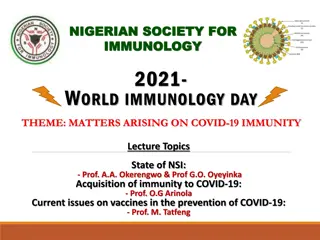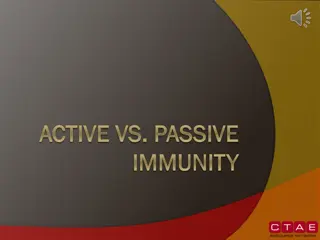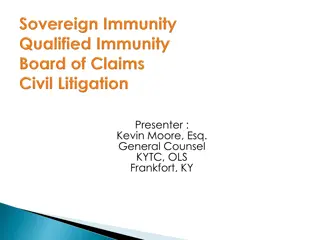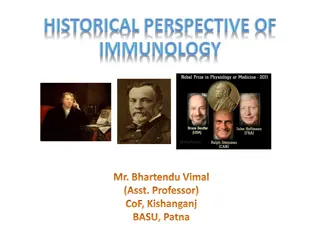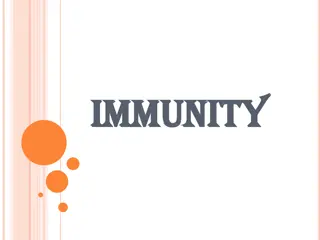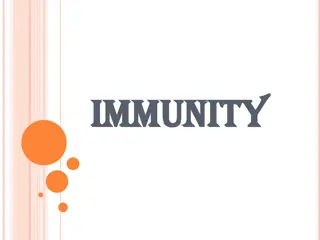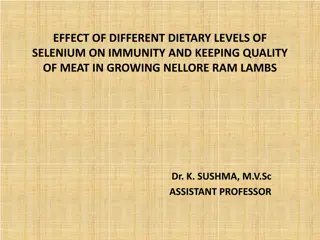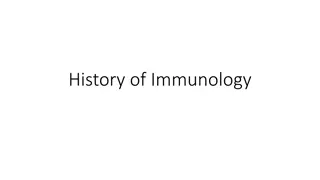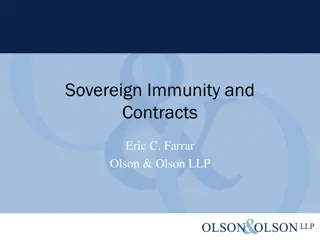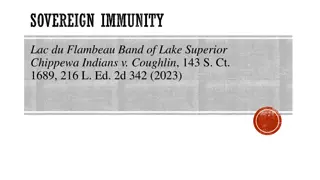Understanding Immunity: Types and Functions Explained
Immunity is the body's defense mechanism against pathogens, encompassing innate and acquired immunity. It involves resistance to infections and foreign antigens, inherited or acquired. Innate immunity provides the first line of defense, while acquired immunity can be active or passive. Species immunity offers protection at a broader level, and understanding these concepts is crucial for maintaining overall health.
Download Presentation

Please find below an Image/Link to download the presentation.
The content on the website is provided AS IS for your information and personal use only. It may not be sold, licensed, or shared on other websites without obtaining consent from the author. Download presentation by click this link. If you encounter any issues during the download, it is possible that the publisher has removed the file from their server.
E N D
Presentation Transcript
IMMUNITY IMMUNITY
IMMUNITY INTRODUCTION The term Immunity has traditionally referred to the resistance exhibited by the host towards injury caused by microorganism and their product. However, protection against infectious disease is only one of many consequences of immune response, which in its entirety is concerned with the reaction of the body against any foreign antigen. Immunity is present in an individual from birth and it is the resistance towards infection. It may Inherited or acquired from the mother The state of protection has both less specific and more specific component.
DEFINITION Immunity is defined as the ability to resist pathogens and their toxic products that tent to damage the tissue or organs. The term "immune" is derived from Latin word immunis Which means "exempt from taxes". Today of course, immunity refers to the body's ability to resist infection by pathogenic micro organisms and their products.
TYPES OF IMMUNITY There are mainly two types Innate immunity Acquired immunity Innate immunity are two types Non-specific Specific Non-specific are three types Species Racial Individual Specific are three types Species Racial Individual
Acquired immunity are two types Active Passive Active immunity are two types Natural Artificial Passive Immunity are two types Natural Artificial
INNATE IMMUNITY OR NATIVE IMMUNITY This provides the first line of defence infection. It is resistance to infections that an individual possesses by virtue of her or his genetic and constitutional make-up. It is not affected by prior contact With microorganisms or immunisation. It may be non -specific when it indicates a degree of resistance to infections in general, or specific, where resistance to a particular pathogen is concerned. Innate immunity may be considered at the level of the species, race or individual.
SPECIES IMMUNITY This refers to the total or relative refractoriness to a pathogen, shown by all members of a species. For instance, all human beings are totally unsusceptible to plant pathogens and to many animal pathogens such as rinderpest and distemper. This immunity is something a person obtains by virtue of being a part of the human species. The mechanisms of species immunity are not clearly understood but may be due to physiological and biochemical differences between the tissue of the different host species, which determine whether or not a pathogen can multiply in them.
RACIAL IMMUNITY Within a species different races may show differences in susceptibility to infection, the classic example of which is the high resistance of Algerian sheep to anthrax. Such racial differences are known to be genetic in origin, and by selection and inbreeding, it is possible to develop, at will, races that possess high degree of resistance or susceptibility to various pathogens. It is difficult to demonstrate marked differences in immunity in human races , as controlled breeding is not possible. It has been reported that people of African origin in the USA are more susceptible then Caucasians to tuberculosis. But such comparisons are vitiated by external influences such as differences in socioeconomic levels.
An interesting instance of genetic resistance to Plasmodium falciparum malaria is seen in some parts of Africa and the Mediterranean coast. A hereditary abnormality of red cells (sickling) prevalent in the area confers immunity to infection by the malarial parasite and may have evolved from the survival advantage conferred by it in a malarial environment.
INDIVIDUAL IMMUNITY This is the difference in innate immunity exhibited by different individuals in a race. The genetic basis of individual immunity is evident from studies on the incidence of infectious diseases in twins . It is well documented that homozygous twins exhibit similar degrees of resistance or susceptibility to lepromatous leprosy and tuberculosis. Such correlation is not seen in heterozygous twins.
FACTORS AFFECTING INNATE IMMUNITY AGE HORMONAL INFLUENCES NUTRITION
AGE The very young and the very old are more susceptible to infectious disease than the rest. The fetus in utero is normally protected from maternal infection by the placental barrier. But some pathogens cross this barrier, causing overwhelming infection resulting in fetal death. Some, such as rubella , herpes, cytomegaloviruses and Toxoplasma gondii, lead to congenital malformations. Tinea capitis caused by Microsporum audouinii frequently undergoes spontaneous cure with the onset of puberty.
HORMONAL INFLUENCE Endocrine disorders such as diabetes mellitus, hypothyroidism and adrenal dysfunction are associated with enhanced susceptibility to infection. The high incidence of staphylococcal sepsis in diabetes may be related to the increased level of carbohydrates in tissue. Corticosteroids exert an important influence on the response to infection. They depress the host s resistance by their anti-inflammatory and anti-phagocytic effects and by suppression of antibody formation and hypersensitivity. They also have a beneficial effect in that neutralise the harmful effect of bacterial products such as endotoxins.
NUTRITION The relationship between malnutrition and immunity is complex but, in general, both humoral and cell-mediated immune processes are reduced when there is malnutrition. Cell-mediated immune responses such as the Mantoux test become negative in severe protein deficiency, as in Kwashiorkor. Malarial infection in the famine stricken may not induce fever but once their nutrition improves , clinical malaria develops.
MECHANISMS OF INNATE IMMUNITY Epithelial surfaces- The intact skin and mucous membrane covering the body protect it considerably against invasion by microorganisms. They provide much more than a mechanical barrier. Healthy skin possesses bactericidal activity to which the presence of a high concentration of salt in drying sweat, sebaceous secretions and long chain fatty acids and soaps contribute. When culture of typhoid bacilli placed on healthy skin and on a glass surface are sampled at intervals, the bacteria on the skin are seen to be killled within minutes ,while those on the glass survive for several hours. The bactericidal activity of skin secretions is illustrated by the frequent mycotic and pyogenic infections seen in person who immerse their hands in soapy water for long periods occupationally. Though skin frees itself readily of bacteria deposited on it (transients),its reactions are different to the bacterial flora normally resident on it. Resident flora are not easily removed even by washing and application of disinfectants. Antibacterial substances in blood and tissues- Several substances possessing antibacterial properties have been described in blood and tissues.
Beta lysin, a relatively thermostable substance active against anthrax and related bacilli. Microbial antagonisms- The skin and mucous surfaces have resident bacterial flora which prevent colonisation by pathogens. Cellular factors- Natural defence against the invasion of blood and tissues by microorganisms and other foreign particles is mediated to a large extent by phagocytic cells which ingest and destroy them. Inflammation- Tissue injury or irritation, initiated by the entry of pathogens or other irritants , lead to inflammation, which is an important, non-specific defence mechanism. FEVER- A rise in temperature following infection is a natural defence mechanism. ACUTE PHASE PROTEINS- Infection or injury leads to a sudden increase in the plasma concentration of certain proteins, collectively called acute phage proteins. TOLL-LIKE RECEPTORS- Many of the molecules involved in innate immunity have the property of pattern recognition, the ability to recognise a given class of molecules.
ACQUIRED IMMUNITY OR ADAPTIVE IMMUNITY The resistance that an individual acquires during life by recognising and selectively eliminating specific foreign molecules is known as acquired immunity. This is displays four characteristic features: ANTIGENIC SPECIFICITY-The immune system or antibodies can distinguish among antigens, even between two proteins that differ in only one amino acid. DIVERSITY- The immune system is capable of generating enormous antibody diversity in its recognition molecules, allowing it to reorganise billions of unique structures/patterns on foreign antigens. Genes form the basis of such diversity. IMMUNOLOGIC MEMORY-The immune system exhibits memory on the second encounter of the same antigen by generating a secondary response which is more specific, heightened and quick.
SELF/NON-SELF RECOGNITION- Self-tolerance is one of the unique characteristics of the immune system which prevents it from reacting to the body s own molecules while still effectively eliminating foreign antigens. Multiple mechanisms ensure Self-tolerance. Failure of these mechanisms may lead to autoimmunity.
TYPES OF ACQUIRED OR ADAPTIVE IMMUNITY ACTIVE IMMUNITY This is resistance developed by an individual as a result of antigenic stimulus. It is also known as adaptive immunity as it represents the adaptive response of the host to a specific pathogen or other antigen. It involves the active functioning of host s immune apparatus, leading to the synthesis of antibodies and the production of immunologically active cells. It sets in only after a latent period which is required for the immunological machinery to be set in motion. During the development of active immunity, there is often a negative phase during which the level of measurable immunity may actually be lower than it was before the antigenic stimulus.
This is because the antigen combines with any pre-existing antibody and lowers its level in circulation. Once developed, active immunity is long-lasting. If an individual who has been actively immunised against an antigen experiences the same antigen subsequently, the immune response occurs more quickly and abundantly than during the first encounter. This is known as secondary response. Besides the development of humoral and cellular immunity, active immunity is associated with immunological memory. Active immunisation is more effective and confers better protection than passive immunisation.
PASSIVE IMMUNITY: This is the resistance that is transmitted passively to a recipient in a' readymade form. Here the recipient s the immune system plays no active role. There is no antigenic stimulus; instead, performed antibodies are administered. There is no latent period, protection being effective immediately after passive immunisation. There is no negative phase. No secondary type response occurs in passive immunity. Passive immunisation is less effective than active immunisation. The main advantage of passive immunisation is that it acts immediately, and therefore, can be employed when instant immunity' is desired.
TYPES OF ACTIVE IMMUNITY 1.NATURAL ACTIVE IMMUNITY Natural active immunity results from either a clinical or an inapparent infection by a microbe. A person who has recovered from an attack of measles develop natural active immunity. The large majority of adults in the developing countries possess natural active immunity to poliomyelitis due to repeated inapparent infections in childhood. Such immunity is usually long-lasting but the duration varies with the type of pathogen. The immunity is lifelong following many viral diseases such as chickenpox and measles. In SYPHILIS, a special type of immunity known as premunition is seen .
2 . ARTIFICIAL ACTIVE IMMUNITY Artificial active immunity is the resistance induced by vaccines. BACTERIAL VACCINES Live(BCG vaccine for tuberculosis) Killed. (Cholera vaccine) Subunit (Typhoid Vi antigen) Bacterial products (Tetanus toxoid) VIRAL VACCINES Live (Oral polio vaccine-Sabin) Killed (Injectable polio vaccine-Salk) Subunit (Hepatitis B Vaccine)
LIVE VACCINES Live vaccines initiate infection without causing any injury or disease. The immunity following live vaccine administration therefore parallels that following natural infection though it may be of a lower order. The immunity lasts for several years but booster doses may be necessary. Live vaccines may be administered orally (as with the Sabin vaccine for poliomyelitis) or parenterally (as with the measles vaccine).
KILLED VACCINES Killed vaccines are generally less immunogenic than live vaccines, and protection lasts only for a short period. They have, therefore, to be administered repeatedly, generally at least two doses being required for the production of immunity. The first is known as the primary dose and the subsequent doses as booster doses. Killed vaccines may be given orally but this route is generally not effective. Parenteral administration provides humoral antibody response, which may be improved by addition of ADJUVANTS (for example, aluminium phosphate).
TYPES OF PASSIVE IMMUNITY 1.Natural passive immunity Natural passive immunity is the resistance passively transferred from mother to baby. In human infants, maternal antibodies are transmitted predominantly through the placenta, while in animals such as pigs, transfer of antibodies occurs mainly orally through the colostrum. The human colostrum, which is also rich in IgA antibodies resistant to intestinal digestion, gives protection to the neonate. The human fetus acquires some ability to synthesise antibodies (IgM) from about the twentieth week of life but it s immunological capacity is still inadequate at birth. It is only by about the age of three months that the infant acquires some measure of immunological independence. Until then, maternal antibodies give passive protection against infectious diseases to the infant.
2.ARTIFICIAL PASSIVE IMMUNITY Artificial passive immunity is the resistance passively transferred to a recipient by the administration of antibodies. The agents used for this purpose are hyperimmune sera of animal or human origin, convalescent sera and pooled human gamma globulin. These are used for prophylaxis and therapy. Equine hyperimmune sera such as antitetanus serum and ATS Prepared from hyperimmunised horses used to be extensively employed. They gave temporary protection but carried the disadvantages of hypersensitivity and immune elimination. Human hyperimmune globulin (for example, tatanus immuneglobulin, TIG) is free from those complications and also provides more lasting protection.
3. COMBINED IMMUNISATION Sometimes a combination of the active and passive methods of immunisation is used . Ideally, whenever passive immunisation is employed for immediate protection, combined immunisation is to be preferred, as in the protection of non immune individual with a tetanus- prone wound. The method is to inject TIG in one arm and the first dose of tetanus toxoid in the other. This is followed by the full coarse of phased tetanus toxoid injections. TIG provides the protection necessary till active immunity is able to take effect.
ADOPTIVE IMMUNITY A special type of immunisation is the injection of immunologically competent lymphocytes. This is known as adoptive immunity. Instead of whole lymphocytes, an extract of immunologically competent lymphocytes, known as the transfer factor can be used. This has attempted in the treatment of certain types of diseases for example lepromatous leprosy.
LOCAL IMMUNITY Natural infection on the live virus vaccine administered intranasally provides local immunity. A special class of immunoglobulins (IgA) forms the main component of local immunity. One type of IgA antibody called secretory IgA is produced locally by plasma cells present on mucosal surfaces or in secretory glands. There appears to be selective transport of sach antibodies between the various mucosal surfaces and secretory glands.
HERD IMMUNITY This refers to the overall level of immunity in a community and is relevant in the control of epidemic diseases. When a large proportion individuals in a community are immune to a pathogen, the herd immunity to the pathogen is satisfactory. When heard immunity is low epidemics are likely to occur on the introduction of a suitable pathogen, due to the presence of large numbers of suceptible individuals in the community. Eradication of communicable diseases depends on the development of high level of herd immunity rather than on the development of a high level of immunity in individuals.
REFERENCES Text book of microbiology by R. Ananthnarayan paniker Text book of microbiology by D.R. Arora


